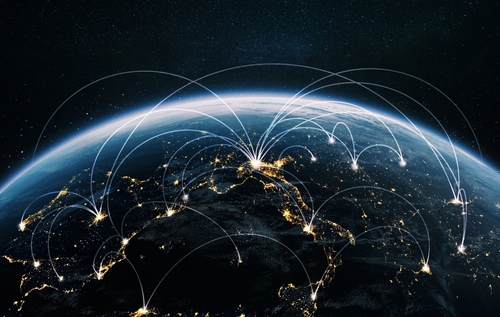Did you know that more than two-thirds of the world’s population—over 5.6 billion people—relies on internet access for communication, education, and business? However, global connectivity is still unequal. The gap between cities, rural areas, and developing regions highlights just how uneven internet access remains. For professionals, educators, and tech enthusiasts, understanding how internet infrastructure varies across countries is essential for exploring opportunities. That’s why we’ve created this guide at Remitly to show you the regions that are well-connected, those that still face challenges, and what it means for everyday life.
You’ll learn how these differences impact individuals, communities, and businesses striving to succeed in an increasingly digital world.
The global connectivity landscape
In 2025, about 68.7% of the world’s population is online, showing steady growth over the last decade. But access isn’t the same everywhere. Cities in wealthy countries often enjoy fast, reliable internet, while rural and remote areas struggle with poor infrastructure.
Middle-income countries are split: Urban hubs tend to stay connected, but many rural areas lag. The global internet challenges are even greater in low-income regions, where unreliable electricity, limited broadband, and high costs make access difficult.
These differences highlight the digital divide and why investing in stronger internet infrastructure is essential for improving global connectivity.

Regions with advanced internet infrastructure
Before diving into emerging markets and growing accessibility, let’s take a closer look at regions with advanced internet infrastructure:
North America
Urban centers like New York, San Francisco, and Toronto benefit from widespread fiber-optic networks and extensive 5G coverage. This makes online learning accessible for local and international students, supports remote work for tech companies, and drives e-commerce growth.
For example, the 5G rollout in cities such as New York and San Francisco has improved connectivity in previously underserved areas, benefiting both urban and nearby rural communities—though it’s true that some rural areas still face slower connections.
Western Europe
Cities such as London, Berlin, and Amsterdam are powered by advanced broadband and 5G networks, enabling digital healthcare, online education, and seamless remote collaboration. Programs like the EU’s Gigabit Society initiative have expanded ultra-fast connectivity, supporting innovation hubs and boosting digital services. Rural regions in some countries do still experience slower access.
South Korea
About 94% of South Koreans use the internet. Cities like Seoul and Busan feature some of the world’s most advanced internet infrastructure, with nearly universal fiber-optic coverage and plans for full 6G deployment by 2030.
High-speed connections fuel e-learning, smart city initiatives, and thriving gaming and tech industries. Students can attend virtual classrooms without interruptions, while businesses leverage fast internet for cloud computing and international operations.
Singapore
Singapore’s Smart Nation initiative has created city-wide high-speed networks and extensive fiber-optic coverage. Residents benefit from opportunities to earn income online, access government services digitally, and use telemedicine for healthcare. This robust infrastructure also supports startups and global companies, reinforcing Singapore’s role as a digital economy leader.

Emerging markets and growing accessibility
Now that we’ve covered advanced regions, let’s dive into how emerging markets are expanding internet access:
India
India has rapidly expanded internet access through initiatives like BharatNet, which connects rural villages and semi-urban communities with high-speed broadband. Telecom companies such as Jio have boosted mobile internet adoption, helping millions of students access online learning and small businesses reach wider markets. Community internet hubs also provide shared access for education and local entrepreneurship.
Brazil
In Brazil, expanding fiber-optic networks and 4G/5G coverage are improving connectivity in cities and semi-urban areas. Programs like “Internet for All” bring affordable internet to remote communities, supporting e-learning, telemedicine, and e-commerce.
The “Wi-Fi Brazil” program has established thousands of free satellite and broadband hotspots, while libraries and community centers serve as important digital hubs.
Africa
Internet access is expanding across parts of Africa thanks to undersea cables, satellite services like Starlink, and local wireless networks. Programs such as SchoolNet Africa provide schools with internet and digital resources.
Community centers in countries like Kenya and Ghana offer training in essential digital skills. These efforts are helping people access education, grow scalable businesses, and engage more fully with their communities.

Challenges of limited internet access
Despite the rapid advancements, many regions around the world still struggle to access reliable internet. These challenges highlight why connectivity remains uneven in many areas:
Geographical barriers
In remote areas like Sub-Saharan Africa, rural South America, the Amazon, and many Pacific Islands, rugged terrain, dense forests, mountains, and long distances from cities make building broadband expensive and technically complex. Conflict zones and natural obstacles also add further complications, preventing or limiting consistent coverage.
Economic limitation
Even where internet infrastructure exists, high data costs, low household incomes, and limited access to devices keep many families offline. This deepens inequality and restricts opportunities for education, healthcare, and work.
Political and security challenges
Unstable governments and civil unrest can damage infrastructure or cause intentional shutdowns. In areas with these challenges, internet access is unreliable or frequently disrupted, isolating communities and limiting participation in the digital economy.
Limited digital literacy
Even with internet access, many people lack the skills to use it effectively. This prevents students from learning online and hinders entrepreneurship by preventing individuals from running e-commerce businesses or reaching wider markets. Communities might also find it difficult to benefit from telemedicine or government services.
Infrastructure vulnerability
Extreme weather, natural disasters, and aging equipment also create global internet challenges that can disrupt connectivity. Areas prone to floods, storms, or earthquakes often face prolonged outages, leaving communities without critical services and communication tools.

Inequality and the digital divide
Even as global internet access expands, disparities that create significant socioeconomic gaps remain. People in well-connected regions have opportunities to advance education, start businesses, and access digital services. However, those in underconnected areas face limitations that extend beyond technology.
Gender and income disparities
Limited internet access often hits women and low-income households the hardest. In some regions, girls and women have lower connectivity, restricting opportunities for skill building, professional networking, and participating in the digital economy.
Likewise, families with tight budgets may have to choose between essentials and internet access, widening social and economic gaps.
Bridging the gap
Several initiatives are helping close the digital divide worldwide. In rural India, the PM-WANI scheme is rolling out affordable public Wi-Fi, while Kenya’s BRCK Moja Wi-Fi sets up community hotspots in schools and public spaces. Affordable data plans from providers like Claro in Latin America aim to make connectivity more accessible.
Beyond access, NGOs and governments are boosting digital skills. Programs like Worldreader in Ghana and Colombia’s Vive Digital help communities use the internet for learning, business, and civic engagement. Together, these efforts are helping more people join the digital world.
The future of global internet connectivity
Over the next decade, ambitious projects and new technologies could bring reliable internet to even the most remote corners of the world.
Innovation driving expansion
- Satellite-based internet: Mega constellations like Starlink, Oneweb, and Amazon’s project Kuiper are expanding satellite internet for underserved areas by launching thousands of satellites in low-earth orbit, aiming to bring high-speed networks to rural and remote communities.
- Undersea cable projects: Initiatives such as Google’s Equiano cable in Africa and Meta’s 2Africa project are laying high-capacity cables across continents to deliver faster and more affordable connections to developing regions.
- 5G rollouts: Internet providers are gradually expanding 5G networks into underserved towns and semi-urban areas, aiming to boost reliability and enable services like remote healthcare and smart agriculture.
Visionary experiments
- Internet balloons: While Alphabet’s project Loon has ended, it sparked research into high-altitude balloons that can provide temporary or emergency internet coverage after natural disasters.
- Wi-Fi drones: Companies are experimenting with solar-powered drones that can stay afloat for months, bringing the internet to areas where building infrastructure is difficult. For example, although now discontinued, Facebook’s Aquila project tested high-altitude drones to beam connectivity to remote parts of Africa, inspiring new prototypes from startups and aerospace firms.
Challenges ahead
For these efforts to succeed, governments and companies need to tackle several challenges:
- Sustainability: Minimizing the environmental impact of launching thousands of satellites and building large-scale infrastructure
- Affordability: Making sure new technologies remain accessible and don’t leave low-income households behind
- Digital sovereignty: Clarifying who controls global networks and ensuring reliance on private companies does not compromise national autonomy
- Cybersecurity and privacy: Safeguarding users in systems where global connectivity spans borders and regulations are limited

Closing the connectivity gap
The global picture of internet access shows both impressive progress and persistent inequality. While billions enjoy high-speed connections, millions are still left offline. Today, connectivity isn’t a luxury—it’s essential for education, economic opportunity, and innovation.
Bridging this digital divide requires collaboration between governments, businesses, and communities. Investing in affordable infrastructure, expanding digital literacy, and creating inclusive solutions are key to ensuring everyone benefits from the digital age. From satellite network to community Wi-Fi, the tools are there, but scaling them fairly is the real challenge.
For readers, professionals, and decision-makers, staying informed is the first step. Understanding the initiatives shaping tomorrow’s internet can help you see how global connectivity trends might impact your work, business strategies, or personal tech needs.
FAQs
Why is internet access so important today?
The internet drives education, work, healthcare, and global communication. It’s become essential for learning, running a business, and staying connected. Without it, communities risk falling behind in skills, opportunities, and access to vital information.
What are the main factors limiting internet access globally?
Access depends on geography, economic development, infrastructure, political stability, and the affordability of devices and data. These factors often overlap, leaving rural areas and low-income regions the most disconnected.
Who is working to improve internet access globally?
Governments invest in broadband programs, NGOs teach digital skills, and tech companies like Starlink experiment with new delivery methods. Community Wi-Fi initiatives also expand coverage in underserved areas. Together, these efforts are helping close the digital divide faster than any single solution could.
What future connectivity solutions are being explored?
Future solutions include satellite internet like Starlink, undersea cables such as Equiano and 2Africa, 5G network expansions, and emerging technologies like Wi-Fi drones and high-altitude balloons. These aim to bring faster, more reliable internet to remote and underserved areas.
What is satellite-based internet and how can it help underserved areas?
Satellite internet uses orbiting satellites instead of ground cables, making it possible to connect remote schools, clinics, and villages. Services like Starlink bring high-speed access to mountains, deserts, and islands where laying cable is difficult or expensive.
How will 5G impact global internet access?
5G offers faster speeds, lower latency, and the ability to connect more devices. It can unlock opportunities in telemedicine, smart farming, and automation, but its benefits depend on local infrastructure and investment. Widespread rollout could drive economic growth and digital innovation in both urban and rural areas.
